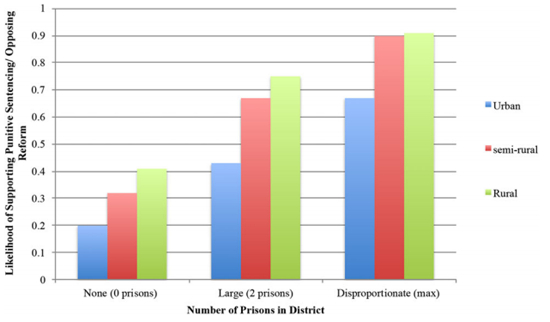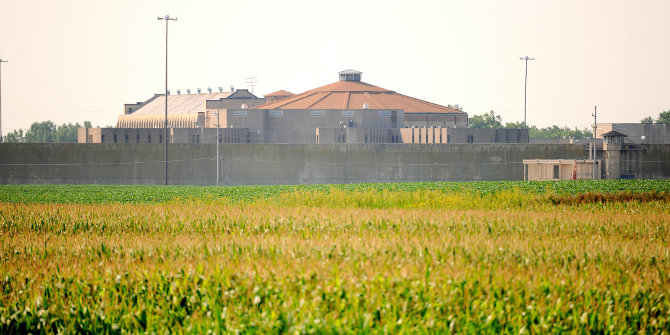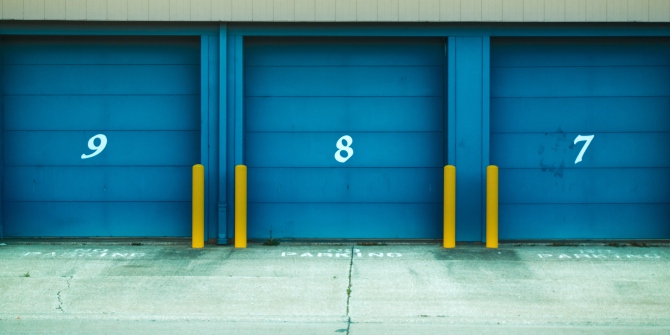 While the US is a currently world leader in incarceration, recent reforms to state and federal sentencing laws provide some hope that this may not always be the case. In new research, Rebecca Thorpe examines one challenge to reducing mass incarceration – the desire of state lawmakers in rural communities to uphold harsh sentencing laws and to block reforms. She argues that these legislators are motivated by a desire to locate and keep prisons as job creators in what are often poor rural areas, and to inflate these areas’ census populations in order to increase political representation and state funding.
While the US is a currently world leader in incarceration, recent reforms to state and federal sentencing laws provide some hope that this may not always be the case. In new research, Rebecca Thorpe examines one challenge to reducing mass incarceration – the desire of state lawmakers in rural communities to uphold harsh sentencing laws and to block reforms. She argues that these legislators are motivated by a desire to locate and keep prisons as job creators in what are often poor rural areas, and to inflate these areas’ census populations in order to increase political representation and state funding.
With 2.2 million Americans incarcerated, the United States holds the dubious distinction as the world’s largest jailer. It is also the most racially biased: Black Americans are nearly six times as likely as whites to end up in prison or jail, and Latinos are more than twice as likely.
Prior to the 1970s, America’s imprisonment rate was relatively stable and on par with other Western democracies. However, from the mid-1970s to the mid-90s, the nation’s incarceration rate quadrupled from 150 people per 100,000 to about 600 per 100,000. Incarceration peaked at 767 per 100,000 in 2007, before leveling off at 698 per 100,000 in 2013.
Currently, the unsustainable fiscal costs of incarceration and increasingly lenient public attitudes toward non-violent drug use have catalyzed a slate of bipartisan reforms to state and federal sentencing and drug laws. Both Republican and Democratic presidential hopefuls denounce harsh punishments for non-violent offenders, and some states such as Colorado have decriminalized or legalized marijuana. Many observers are optimistic that the destructive surge of mass incarceration will soon be reversed.
However, reform may be more difficult than these signs suggest. My recent research suggests that incarceration advances powerful interests separate from promoting public safety and satiating an anxious public. Rather, incarceration also became a solution to the geographic concentration of poverty and joblessness among low-skilled workers in isolated urban and rural spaces cut off from resources, money, prestige and opportunity.
Specifically, while disproportionate numbers of young black and Hispanic men living in impoverished urban districts were labeled criminal, taken off the streets, and put in warehouses, prisons became a jobs program throughout rural America.
A large body of literature highlights the convergence of 1960s race riots and civil rights gains as the foundation for a punitive punishment regime. Policymakers employed draconian tactics to crush black power movements, while exploiting white fears of black criminality and passing harsh criminal penalties to secure reelection. For example, policymakers raced to pass Three Strikes Laws required 25-year to life sentences for a third offense, mandatory 10-, 20-, and 30-year minimum sentences for violent and non-violent acts, and sentencing laws increased the number offenses resulting in life sentence without parole.
I argue that incarceration can be more fully explained by disinvestment and destabilization that led to spatially concentrated poverty and joblessness in black urban neighborhoods as well as many predominantly white rural spaces. Policymakers reacted not only to white racial animus, but also to soaring levels of violent crime—which grew 4-fold from 1960 to the early 1990s before declining steadily in subsequent decades—moral panics over underground markets and illegal drug use, and severe economic dislocations which created a jobs crisis for America’s poor and working classes.
In the 1960s and 70s, manufacturing jobs disappeared from cities and emerged in suburbs and offshore. The loss of work and sharp reductions in social welfare programs fueled unemployment and concentrated black urban poverty. These structural changes were compounded by a history of racially discriminatory banking, lending and housing practices, including low interest mortgages for white homeowners and predatory lending for blacks. Freeway construction, public housing projects and exclusive zoning laws fortified racially homogenous white suburbs at the expense of black residents trapped in cities. Meanwhile, the national homicide rate doubled between 1960 and the early 1970s, and violence became more geographically concentrated within poor, black communities.
Structural changes in the global economy also contributed to deep poverty within rural spaces. Rural communities faced sharp declines in historically dominant agricultural, logging and mining sectors during a period of reduced social service provisions. These trends fueled “pockets of persistent poverty” throughout rural America.
In the 1960s and 1970s—when US incarceration rates were relatively stable and on par with other Western democracies—most prisons were located in metropolitan areas where prisoners are typically arrested and where they last held an address. However, rural communities built hundreds of new prisons in the 1980s and 1990s, accounting for most new prison growth. Political and business elites capitalized on demand for cheap land and untapped labor in order to bring jobs and capital to economically distressed, rural communities.
The political consequences are self-perpetuating: First, the chronic loss of employment and revenue made prison development a superficially attractive investment option throughout declining, rural areas. Although prisons do not typically improve the local economy in the long-run, many under-developed rural spaces lack other viable employment alternatives. These areas aggressively compete for prisons to draw construction, infrastructure and related service industries, but also grow to rely on these institutions as a principal source of jobs and revenue. This creates political pressure to keep existing prisons full.
Second, the census practice of counting inmates as residents of the communities where they are imprisoned artificially inflates population counts in otherwise shrinking rural areas. These census figures are used to determine political representation in state and federal legislatures, as well as formulas for state and federal funding for social welfare and economic development.
In new research, I compiled an original dataset consisting of the location, size, and operating capacity of state, federal, and private prisons in California, New York, and Washington State from 2000–2010. I use these data to examine whether state legislators representing rural communities that host prisons support harsh criminal punishments for non-violent offenses more than other legislators in the same political party and with shared ideological goals.
My analysis suggests that state lawmakers representing rural communities with correctional institutions consistently vote to uphold harsh sentencing laws and block reform efforts. Notably, as Figure 1 shows, a subset of Democratic state legislators representing rural prison communities routinely break with their party leadership and oppose measures to curb imprisonment rates.
Figure 1 – Estimated influence of prison economy on Democratic state legislators’ opposition to drug law reforms, New York State, 2007–2008

Note: Figure 2 displays predicted values calculated by the author from the logit analysis in Appendix 4 using CLARIFY. Population density is set to its ninth decile (urban), first quartile (semi-rural), and first decile (rural). The number of prisons is set to its minimum, mid-range, and maximum value. All values displayed are statistically significant at the 95 percent confidence level. All control variables are held constant at their sample means.
This evidence indicates that rural prisons link the economic stability and political power of many lower-class rural spaces to punitive criminal sanctions that disproportionately harm poor, non-white urban neighborhoods. Rural communities that host prisons aggressively support punitive policies and lobby against alternative approaches because they stand to gain from prison growth.
Despite the apparent momentum behind new reform efforts, growing fiscal constraints and plummeting crime rates, the perverse spatial logic of prison development entrenches powerful political and economic interests in maintaining carceral punishment. Incarceration warehouses outsized numbers of the urban poor, while sustaining many impoverished rural spaces.
This article is based on the paper, ‘Perverse Politics: The Persistence of Mass Imprisonment in the Twenty-first Century’, in Perspectives on Politics.
Featured image credit: Jim Larrison (Flickr, CC-BY-2.0)
Please read our comments policy before commenting.
Note: This article gives the views of the author, and not the position of USAPP – American Politics and Policy, nor the London School of Economics.
Shortened URL for this post: http://bit.ly/1YiZWIW
_________________________________
 Rebecca U. Thorpe – University of Washington
Rebecca U. Thorpe – University of Washington
Rebecca U. Thorpe is an Assistant Professor at the University of Washington. Her research interests include political institutions and state development, with an emphasis on U.S. military spending and warfare, criminal punishment, and imprisonment. She is the author of The American Warfare State: The Domestic Politics of Military Spending (University of Chicago 2014) and “Perverse Politics: The Persistence of Mass Incarceration in the 21st Century” (Perspectives on Politics, Sept. 2015).





